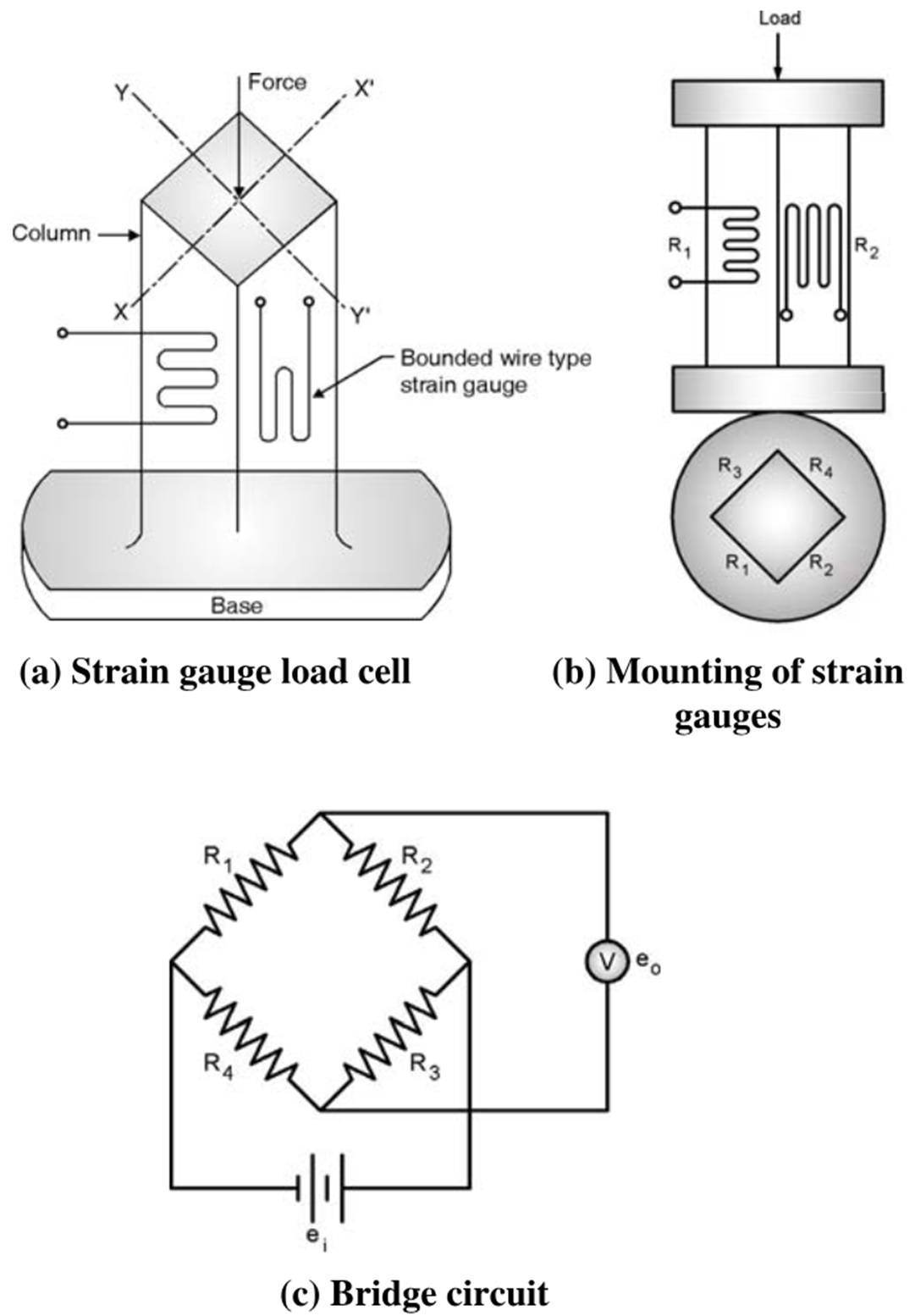A strain gauge load cell is a force-measuring device that converts mechanical force into an electrical signal. It operates based on the principle of strain measurement, where an applied force deforms a structure, and the strain gauge sensors detect the change in resistance, providing an accurate weight or force measurement.

Explanation of the Strain Gauge Load Cell Diagram
(a) Strain Gauge Load Cell: Shows the column structure with strain gauges mounted to detect deformation.
(b) Mounting of Strain Gauges: Depicts how strain gauges are placed on the load cell structure.
(c) Bridge Circuit: Represents the Wheatstone bridge configuration used to convert strain-induced resistance changes into voltage variations.
Construction of Strain Gauge Load Cell
A typical strain gauge load cell consists of the following components:
- Elastic Element: A metallic body (often aluminum or stainless steel) that deforms under applied force.
- Strain Gauges: Thin wire or foil resistors bonded to the elastic element that change resistance when stretched or compressed.
- Wheatstone Bridge Circuit: A circuit arrangement with four resistors (strain gauges) to measure the small resistance changes.
- Excitation Voltage Source: Provides a stable voltage to the Wheatstone bridge.
- Output Signal Amplifier: Boosts the weak signal from the bridge for further processing.
- Protective Enclosure: Ensures durability and protection against environmental conditions.
Working Principle of Strain Gauge Load Cell
The working mechanism of a strain gauge load cell involves the following steps:
- Load Application: A force is applied to the load cell, causing deformation of the elastic element.
- Strain Gauge Response: The strain gauges experience tension or compression, altering their resistance.
- Wheatstone Bridge Output: The resistance changes create an unbalanced bridge, generating a small voltage signal proportional to the applied force.
- Signal Amplification: The small voltage is amplified and converted into a readable digital or analog output.
- Measurement Interpretation: The amplified signal is processed and displayed as force or weight.
Types of Strain Gauge Load Cells
There are several types of strain gauge load cells based on application and design:
| Type | Description | Common Applications |
|---|---|---|
| Beam Load Cells | Used for mid-range weight measurements. | Weighing scales, industrial applications. |
| Column Load Cells | Designed for high-capacity loads. | Bridge and structural testing. |
| S-Type Load Cells | Capable of measuring tension and compression. | Material testing, force measurement. |
| Cantilever Load Cells | For small-scale precision force measurement. | Laboratory applications, force sensors. |
| Shear Beam Load Cells | For heavy-duty industrial applications. | Truck scales, load monitoring. |
| Single-Point Load Cells | Provides high accuracy in small applications. | Retail weighing, precision scales. |
Advantages of Strain Gauge Load Cell
Strain gauge load cells offer several benefits:
- High Accuracy: Provides precise force measurement.
- Compact and Lightweight: Suitable for various applications.
- Wide Load Range: Available for small to heavy loads.
- Durability: Can withstand harsh industrial environments.
- Minimal Power Consumption: Efficient for continuous operation.
- Digital Compatibility: Easily integrates with computer-based measurement systems.
Disadvantages of Strain Gauge Load Cell
Despite its advantages, some limitations include:
- Susceptible to Temperature Variations: Requires compensation circuits.
- Requires Calibration: Needs regular calibration for accuracy.
- Sensitive to Overloading: Can be damaged by excessive force.
- Installation Complexity: Requires proper mounting and wiring.
Applications of Strain Gauge Load Cell
Strain gauge load cells are widely used across various industries:
- Industrial Weighing: Found in conveyor scales, tank weighing systems, and platform scales.
- Aerospace and Automotive Testing: Used for force and stress analysis in vehicles and aircraft.
- Medical Devices: Applied in prosthetics, surgical equipment, and rehabilitation devices.
- Material Testing Machines: Utilized for tensile and compression testing.
- Robotics and Automation: Helps in force feedback and precision motion control.
- Structural Monitoring: Used in bridges, buildings, and large structures to detect stress and strain.
Conclusion
The Strain Gauge Load Cell is a highly accurate and versatile force measurement tool widely used in industrial, medical, and research applications. It operates based on the strain-induced resistance changes, which are converted into measurable electrical signals via a Wheatstone bridge circuit. Despite some limitations like temperature sensitivity and the need for regular calibration, its advantages make it a preferred choice for various precision measurement tasks.
